Yining Hong
From Hazard Identification to Controller Design: Proactive and LLM-Supported Safety Engineering for ML-Powered Systems
Feb 11, 2025Abstract:Machine learning (ML) components are increasingly integrated into software products, yet their complexity and inherent uncertainty often lead to unintended and hazardous consequences, both for individuals and society at large. Despite these risks, practitioners seldom adopt proactive approaches to anticipate and mitigate hazards before they occur. Traditional safety engineering approaches, such as Failure Mode and Effects Analysis (FMEA) and System Theoretic Process Analysis (STPA), offer systematic frameworks for early risk identification but are rarely adopted. This position paper advocates for integrating hazard analysis into the development of any ML-powered software product and calls for greater support to make this process accessible to developers. By using large language models (LLMs) to partially automate a modified STPA process with human oversight at critical steps, we expect to address two key challenges: the heavy dependency on highly experienced safety engineering experts, and the time-consuming, labor-intensive nature of traditional hazard analysis, which often impedes its integration into real-world development workflows. We illustrate our approach with a running example, demonstrating that many seemingly unanticipated issues can, in fact, be anticipated.
SlowFast-VGen: Slow-Fast Learning for Action-Driven Long Video Generation
Oct 30, 2024



Abstract:Human beings are endowed with a complementary learning system, which bridges the slow learning of general world dynamics with fast storage of episodic memory from a new experience. Previous video generation models, however, primarily focus on slow learning by pre-training on vast amounts of data, overlooking the fast learning phase crucial for episodic memory storage. This oversight leads to inconsistencies across temporally distant frames when generating longer videos, as these frames fall beyond the model's context window. To this end, we introduce SlowFast-VGen, a novel dual-speed learning system for action-driven long video generation. Our approach incorporates a masked conditional video diffusion model for the slow learning of world dynamics, alongside an inference-time fast learning strategy based on a temporal LoRA module. Specifically, the fast learning process updates its temporal LoRA parameters based on local inputs and outputs, thereby efficiently storing episodic memory in its parameters. We further propose a slow-fast learning loop algorithm that seamlessly integrates the inner fast learning loop into the outer slow learning loop, enabling the recall of prior multi-episode experiences for context-aware skill learning. To facilitate the slow learning of an approximate world model, we collect a large-scale dataset of 200k videos with language action annotations, covering a wide range of scenarios. Extensive experiments show that SlowFast-VGen outperforms baselines across various metrics for action-driven video generation, achieving an FVD score of 514 compared to 782, and maintaining consistency in longer videos, with an average of 0.37 scene cuts versus 0.89. The slow-fast learning loop algorithm significantly enhances performances on long-horizon planning tasks as well. Project Website: https://slowfast-vgen.github.io
What Is Wrong with My Model? Identifying Systematic Problems with Semantic Data Slicing
Sep 14, 2024Abstract:Machine learning models make mistakes, yet sometimes it is difficult to identify the systematic problems behind the mistakes. Practitioners engage in various activities, including error analysis, testing, auditing, and red-teaming, to form hypotheses of what can go (or has gone) wrong with their models. To validate these hypotheses, practitioners employ data slicing to identify relevant examples. However, traditional data slicing is limited by available features and programmatic slicing functions. In this work, we propose SemSlicer, a framework that supports semantic data slicing, which identifies a semantically coherent slice, without the need for existing features. SemSlicer uses Large Language Models to annotate datasets and generate slices from any user-defined slicing criteria. We show that SemSlicer generates accurate slices with low cost, allows flexible trade-offs between different design dimensions, reliably identifies under-performing data slices, and helps practitioners identify useful data slices that reflect systematic problems.
FlexAttention for Efficient High-Resolution Vision-Language Models
Jul 29, 2024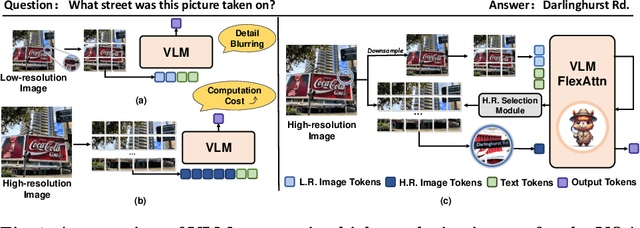
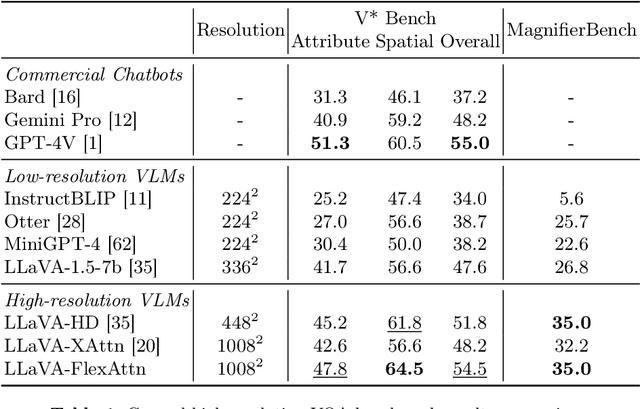
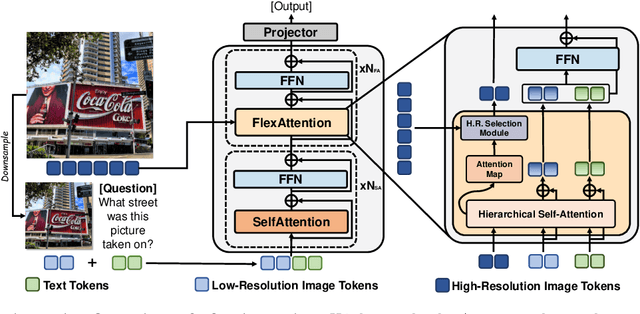
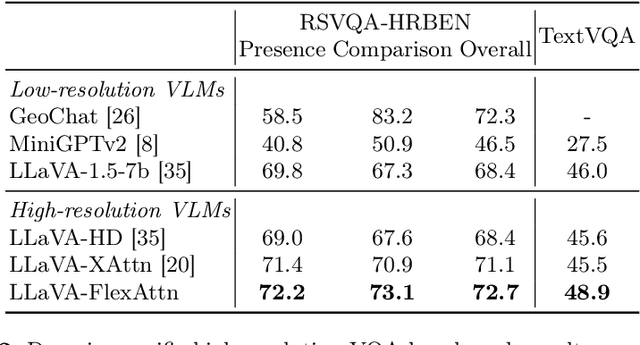
Abstract:Current high-resolution vision-language models encode images as high-resolution image tokens and exhaustively take all these tokens to compute attention, which significantly increases the computational cost. To address this problem, we propose FlexAttention, a flexible attention mechanism for efficient high-resolution vision-language models. Specifically, a high-resolution image is encoded both as high-resolution tokens and low-resolution tokens, where only the low-resolution tokens and a few selected high-resolution tokens are utilized to calculate the attention map, which greatly shrinks the computational cost. The high-resolution tokens are selected via a high-resolution selection module which could retrieve tokens of relevant regions based on an input attention map. The selected high-resolution tokens are then concatenated to the low-resolution tokens and text tokens, and input to a hierarchical self-attention layer which produces an attention map that could be used for the next-step high-resolution token selection. The hierarchical self-attention process and high-resolution token selection process are performed iteratively for each attention layer. Experiments on multimodal benchmarks prove that our FlexAttention outperforms existing high-resolution VLMs (e.g., relatively ~9% in V* Bench, ~7% in TextVQA), while also significantly reducing the computational cost by nearly 40%.
3D-VLA: A 3D Vision-Language-Action Generative World Model
Mar 14, 2024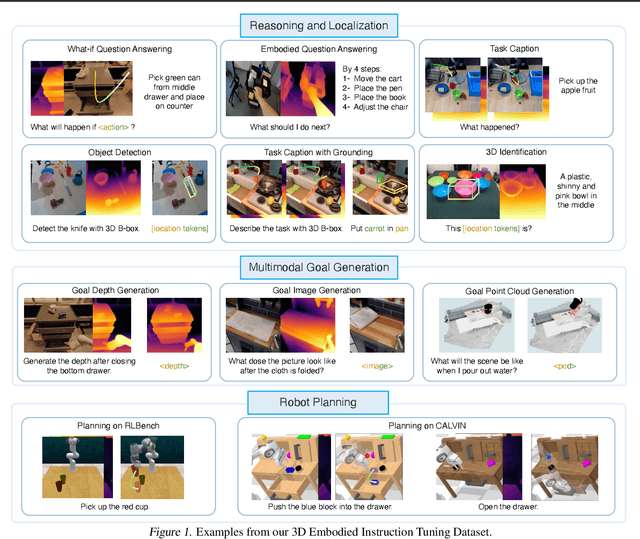
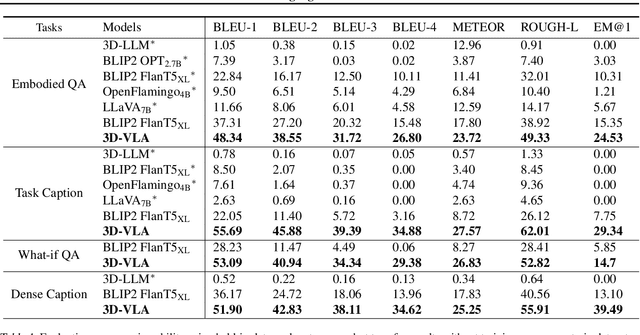
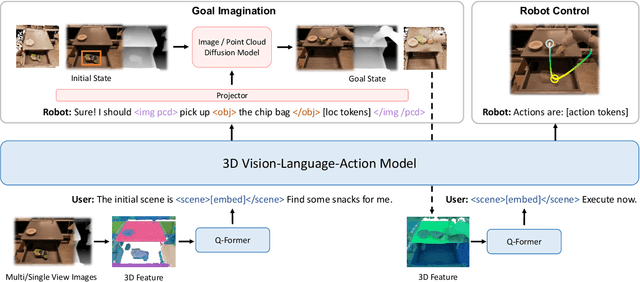

Abstract:Recent vision-language-action (VLA) models rely on 2D inputs, lacking integration with the broader realm of the 3D physical world. Furthermore, they perform action prediction by learning a direct mapping from perception to action, neglecting the vast dynamics of the world and the relations between actions and dynamics. In contrast, human beings are endowed with world models that depict imagination about future scenarios to plan actions accordingly. To this end, we propose 3D-VLA by introducing a new family of embodied foundation models that seamlessly link 3D perception, reasoning, and action through a generative world model. Specifically, 3D-VLA is built on top of a 3D-based large language model (LLM), and a set of interaction tokens is introduced to engage with the embodied environment. Furthermore, to inject generation abilities into the model, we train a series of embodied diffusion models and align them into the LLM for predicting the goal images and point clouds. To train our 3D-VLA, we curate a large-scale 3D embodied instruction dataset by extracting vast 3D-related information from existing robotics datasets. Our experiments on held-in datasets demonstrate that 3D-VLA significantly improves the reasoning, multimodal generation, and planning capabilities in embodied environments, showcasing its potential in real-world applications.
MultiPLY: A Multisensory Object-Centric Embodied Large Language Model in 3D World
Jan 16, 2024



Abstract:Human beings possess the capability to multiply a melange of multisensory cues while actively exploring and interacting with the 3D world. Current multi-modal large language models, however, passively absorb sensory data as inputs, lacking the capacity to actively interact with the objects in the 3D environment and dynamically collect their multisensory information. To usher in the study of this area, we propose MultiPLY, a multisensory embodied large language model that could incorporate multisensory interactive data, including visual, audio, tactile, and thermal information into large language models, thereby establishing the correlation among words, actions, and percepts. To this end, we first collect Multisensory Universe, a large-scale multisensory interaction dataset comprising 500k data by deploying an LLM-powered embodied agent to engage with the 3D environment. To perform instruction tuning with pre-trained LLM on such generated data, we first encode the 3D scene as abstracted object-centric representations and then introduce action tokens denoting that the embodied agent takes certain actions within the environment, as well as state tokens that represent the multisensory state observations of the agent at each time step. In the inference time, MultiPLY could generate action tokens, instructing the agent to take the action in the environment and obtain the next multisensory state observation. The observation is then appended back to the LLM via state tokens to generate subsequent text or action tokens. We demonstrate that MultiPLY outperforms baselines by a large margin through a diverse set of embodied tasks involving object retrieval, tool use, multisensory captioning, and task decomposition.
GENOME: GenerativE Neuro-symbOlic visual reasoning by growing and reusing ModulEs
Nov 08, 2023Abstract:Recent works have shown that Large Language Models (LLMs) could empower traditional neuro-symbolic models via programming capabilities to translate language into module descriptions, thus achieving strong visual reasoning results while maintaining the model's transparency and efficiency. However, these models usually exhaustively generate the entire code snippet given each new instance of a task, which is extremely ineffective. We propose generative neuro-symbolic visual reasoning by growing and reusing modules. Specifically, our model consists of three unique stages, module initialization, module generation, and module execution. First, given a vision-language task, we adopt LLMs to examine whether we could reuse and grow over established modules to handle this new task. If not, we initialize a new module needed by the task and specify the inputs and outputs of this new module. After that, the new module is created by querying LLMs to generate corresponding code snippets that match the requirements. In order to get a better sense of the new module's ability, we treat few-shot training examples as test cases to see if our new module could pass these cases. If yes, the new module is added to the module library for future reuse. Finally, we evaluate the performance of our model on the testing set by executing the parsed programs with the newly made visual modules to get the results. We find the proposed model possesses several advantages. First, it performs competitively on standard tasks like visual question answering and referring expression comprehension; Second, the modules learned from one task can be seamlessly transferred to new tasks; Last but not least, it is able to adapt to new visual reasoning tasks by observing a few training examples and reusing modules.
CoVLM: Composing Visual Entities and Relationships in Large Language Models Via Communicative Decoding
Nov 06, 2023Abstract:A remarkable ability of human beings resides in compositional reasoning, i.e., the capacity to make "infinite use of finite means". However, current large vision-language foundation models (VLMs) fall short of such compositional abilities due to their "bag-of-words" behaviors and inability to construct words that correctly represent visual entities and the relations among the entities. To this end, we propose CoVLM, which can guide the LLM to explicitly compose visual entities and relationships among the text and dynamically communicate with the vision encoder and detection network to achieve vision-language communicative decoding. Specifically, we first devise a set of novel communication tokens for the LLM, for dynamic communication between the visual detection system and the language system. A communication token is generated by the LLM following a visual entity or a relation, to inform the detection network to propose regions that are relevant to the sentence generated so far. The proposed regions-of-interests (ROIs) are then fed back into the LLM for better language generation contingent on the relevant regions. The LLM is thus able to compose the visual entities and relationships through the communication tokens. The vision-to-language and language-to-vision communication are iteratively performed until the entire sentence is generated. Our framework seamlessly bridges the gap between visual perception and LLMs and outperforms previous VLMs by a large margin on compositional reasoning benchmarks (e.g., ~20% in HICO-DET mAP, ~14% in Cola top-1 accuracy, and ~3% on ARO top-1 accuracy). We also achieve state-of-the-art performances on traditional vision-language tasks such as referring expression comprehension and visual question answering.
3D-LLM: Injecting the 3D World into Large Language Models
Jul 24, 2023Abstract:Large language models (LLMs) and Vision-Language Models (VLMs) have been proven to excel at multiple tasks, such as commonsense reasoning. Powerful as these models can be, they are not grounded in the 3D physical world, which involves richer concepts such as spatial relationships, affordances, physics, layout, and so on. In this work, we propose to inject the 3D world into large language models and introduce a whole new family of 3D-LLMs. Specifically, 3D-LLMs can take 3D point clouds and their features as input and perform a diverse set of 3D-related tasks, including captioning, dense captioning, 3D question answering, task decomposition, 3D grounding, 3D-assisted dialog, navigation, and so on. Using three types of prompting mechanisms that we design, we are able to collect over 300k 3D-language data covering these tasks. To efficiently train 3D-LLMs, we first utilize a 3D feature extractor that obtains 3D features from rendered multi- view images. Then, we use 2D VLMs as our backbones to train our 3D-LLMs. By introducing a 3D localization mechanism, 3D-LLMs can better capture 3D spatial information. Experiments on ScanQA show that our model outperforms state-of-the-art baselines by a large margin (e.g., the BLEU-1 score surpasses state-of-the-art score by 9%). Furthermore, experiments on our held-in datasets for 3D captioning, task composition, and 3D-assisted dialogue show that our model outperforms 2D VLMs. Qualitative examples also show that our model could perform more tasks beyond the scope of existing LLMs and VLMs. Project Page: : https://vis-www.cs.umass.edu/3dllm/.
3D Concept Learning and Reasoning from Multi-View Images
Mar 20, 2023Abstract:Humans are able to accurately reason in 3D by gathering multi-view observations of the surrounding world. Inspired by this insight, we introduce a new large-scale benchmark for 3D multi-view visual question answering (3DMV-VQA). This dataset is collected by an embodied agent actively moving and capturing RGB images in an environment using the Habitat simulator. In total, it consists of approximately 5k scenes, 600k images, paired with 50k questions. We evaluate various state-of-the-art models for visual reasoning on our benchmark and find that they all perform poorly. We suggest that a principled approach for 3D reasoning from multi-view images should be to infer a compact 3D representation of the world from the multi-view images, which is further grounded on open-vocabulary semantic concepts, and then to execute reasoning on these 3D representations. As the first step towards this approach, we propose a novel 3D concept learning and reasoning (3D-CLR) framework that seamlessly combines these components via neural fields, 2D pre-trained vision-language models, and neural reasoning operators. Experimental results suggest that our framework outperforms baseline models by a large margin, but the challenge remains largely unsolved. We further perform an in-depth analysis of the challenges and highlight potential future directions.
 Add to Chrome
Add to Chrome Add to Firefox
Add to Firefox Add to Edge
Add to Edge